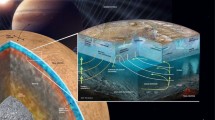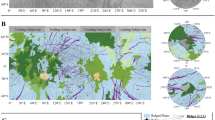Abstract
Spectral analysis method was applied to aeromagnetic data obtained for Ikogosi warm spring (IWS) area of southwestern Nigeria. This was done with the objective of determining the bottom of the magnetized crust called Curie point depth (CDP) and understand the nature and extent of the local geothermal system at depth beneath IWS. The depth to the centroid, Z o, of the deepest distribution of the magnetic dipoles was obtained by computing least-squares fit to the lowest-frequency segment of the azimuthally averaged log power spectrum. The average depth to the top of the deepest crustal block was computed as the depth to the top, Z t, of the second lowest-frequency segment of the spectrum. The depth to the bottom of the deepest magnetic dipoles, the inferred Curie point depth, was then calculated from Z b = 2Z o − Z t. The Curie depth estimates for IWS range between 4.68 and 11.38 km (below sea level). We also estimate the heat flow and Curie temperature using a one-dimensional conductive heat transport model. The average heat flow, 42 mW m−2, and geothermal gradient, 32°C/km, obtained suggest a low enthalpy thermal regime. The Curie temperature for the region varies between 153°C and 350°C. Also, an inverse linear relationship between heat flow and Curie depths was determined. Good agreement between the Curie point depths derived from heat flow data and magnetic data suggests that the Curie point depth analysis is useful to estimate the regional thermal structure and the tectonic settings.








Similar content being viewed by others
References
Adegbuyi O, Ajayi OS, Odeyemi IB (1996) Prospects of hot-dry-rock (HDR) geothermal energy around the Ikogosi warm spring in Ekiti state. Nigeria J Renewal Energy 4:58–64
Adepelumi AA, Ako BD, Ajayi TR, Olorunfemi AO, Awoyemi MO, Falebita DE (2008) Integrated geophysical mapping of the Ifewara transcurrent fault system, Nigeria. J Afr Earth Sci 52:161–166
Akima H (1978) A method of bivariate interpolation and smooth surface fitting for irregularly distributed data points. ACM Trans Math, Soft 4(2):148–159
Bhattacharyya BK, Leu LK (1975a) Spectral analysis of gravity and magnetic anomalies due to two-dimensional structures. Geophysics 40:993–1013
Bhattacharyya BK, Leu LK (1975b) Analysis of magnetic anomalies over Yellowstone National Park: mapping of Curie point isothermal surface for geothermal reconnaissance. J Geophys Res 80:4461–4465
Black R, Caby R, Monssine Pouchkin A, Bayer R, Betrand JM, Boullier AM, Fabre J, Lesquer A (1979) Evidence for late Precambrian plate tectonics in West Africa. Nature 278:223–227
Byerly PE, Stolt RH (1977) An attempt to define the Curie point isotherm in northern and central Arizona’. Geophysics 42:1394–1400
Caby R, Boesse JM (2001) Pan-African Nappe system in south west Nigeria; the Ife-Ilesha Schist Belt. J Afr Earth Sci 33(2):211–225
Connard G, Couch R, Gemperle M (1983) Analysis of aeromagnetic measurements from the Cascade Range in central Oregon. Geophysics 48:376–390
Dada SS (1998) Crustal forming ages and Proterozoic crustal evolution in Nigeria: a reappraisal of current interpretations. Precambrian Res 87:65–74
Espinosa-Cardeña JM, Campos-Enriquez JO (2008) Curie point depth from spectral analysis of aeromagnetic data from Cerro Prieto geothermal area, Baja California, Mexico. J Volcanol Geotherm Res 176:601–609
Gasparini P, Mantovani MSM, Corrado G, Rapolla A (1979) Depth of Curie temperature in continental shields: a compositional boundary? Nature 278:845–846
Lachenbruch AH, Sass JH (1978) Models of an extending lithosphere and heat flow in the Basin and range province. In: Smith RB, Eaton GP (eds) Cenozoic tectonics and regional geophysics of western Cordillera. Geological Society of America memoir, vol 152. Geological Society of America, Boulder, pp 209–250
Lachenbruch AH, Sass JH, Galanis SP Jr (1985) Heat flow in southernmost California and the origin of the Salton trough. J Geophys Res 90:6709–6736
Medina OK (2000) Limnological studies of two contrasting but closely linked springs in Nigeria, West Africa. Plant Biosyst An Int J Dealing Aspects Plant Biol 134(2):123–131
Mushayandebvu MF, Davies J (2006) Magnetic gradients in sedimentary basins: examples from the Western Canada Sedimentary Basin. Lead Edge 25(1):69–73
Nathenson M, Guffanti M (1988) Geothermal gradients in the conterminous United States. J Geophys Res 93:6437–6450
Okubo Y, Graf RJ, Hansen RO, Ogowa K, Tsu H (1985) Curie point depth of the island of Kyushu and surrounding areas, Japan. Geophysics 50:481–494
Okubo Y, Tsu H, Ogawa K (1989) Estimation of Curie point temperature and geothermal structure of island arcs of Japan. Tectonophysics 159:279–290
Onwuemesi AG (1997) One-dimensional spectral analysis of aeromagnetic anomalies and Curie depth isotherm in the Anambra basin of Nigeria. J Geodyn 23(2):95–107
Phillips JD (1997) Potential-field geophysical software for the PC, version 2.2. United State Geological Survey, Open-File Report, 97-725
Porowski A and Dowgiallo J (2008) Application of selected geothermometers to exploration of low-enthalpy thermal water: the Sudetic Geothermal Region in Poland. Environ Geol. doi:10.1007/s00254-008-1409-7
Rahaman MAO (1988) Recent advances in the study of the basement complex of Nigeria. In: Oluyide PO, Mbonu WC, Ogezie AE, Egbuniwe IG, Ajibade AC, Umeji AC (eds) Precambrian Geol Nigeria. Geological Survey of Nigeria, Kaduna, pp 11–41
Reford S (2006) Gradient enhancement of the total magnetic field. Lead Edge 25(1):59–66
Riddihoug RP (1971) Diurnal correction to magnetic survey—an assessment of errors. Geophys Prospect 19(4):551–567
Rogers AS, Imevbore AMA, Adegoke OS (1969) Physical and chemical properties of the Ikogosi warm spring, Western Nigeria. J Min Geol 4:69–81
Salem A, Ushijima K, Elsirafi A, and Muzunaga H (2000) Spectral analysis of aeromagnetic data for geothermal reconnaissance of Quseir area, northern Red Sea, Egypt. Proc World Geoth Congress, pp 1669–1673
Spector A, Grant FS (1970) Statistical models for interpreting aeromagnetic data. Geophysics 35:293–302
Stacey FD, Banerjee SK (1974) The physical principles of rock magnetism. Elsevier, Amsterdam, 195 pp
Stampolidis A, Tsokas G (2002) Curie point depth of Macedonia and Thrace, N. Greece. Pure Appl Geophys 159:1–13
Stampolidis A, Kane I, Tsokas GN, Tsourlos P (2005) Curie point depths of Albania inferred from ground total field magnetic data. Surv Geophys 26:461–480
Tanaka A, Okubo Y, Matsubayashi O (1999) Curie point depth based on spectrum analysis of the magnetic anomaly data in East and Southeast Asia. Tectonophysics 306:461–470
Tselenti GA (1991) An attempt to define Curie point depths in Greece from aeromagnetic and heat flow data. PAGEOPH 136(1):87–101
Tsokas GN, Hansen RO, Fytikas M (1998) Curie point depth of the island of Crete (Greece). Pure Appl Geophys 152:747–757
Turcotte DL, Schubert G (1982) Geodynamics applications of continuum physics to geologic problems. Wiley, New York, 450 pp
Turner DC (1983) Upper Proterozoic schist belts in the Nigerian sector of the Pan-African province of West-Africa. Precambrian Res 21:55–79
Winglink™ (2007) Integrated interpretation software. Geosystem Incorporated, USA
Acknowledgments
The second author wishes to thank TWAS/UNESCO for sponsoring part of this project through the research Grant No. 07-018LDC/GEO/AF/AC-UNESCO FR: 3240144812. Also, the management of Getech Nigeria is appreciated for funding the fieldwork and making the ground magnetic data available to us. Also, the Nigeria Geological Survey Agency is profoundly appreciated for the release of the aeromagnetic data.
Author information
Authors and Affiliations
Corresponding author
Rights and permissions
About this article
Cite this article
Olorunfemi, M.O., Adepelumi, A.A., Falebita, D.E. et al. Crustal thermal regime of Ikogosi warm spring, Nigeria inferred from aeromagnetic data. Arab J Geosci 6, 1657–1667 (2013). https://doi.org/10.1007/s12517-011-0486-1
Received:
Accepted:
Published:
Issue Date:
DOI: https://doi.org/10.1007/s12517-011-0486-1




